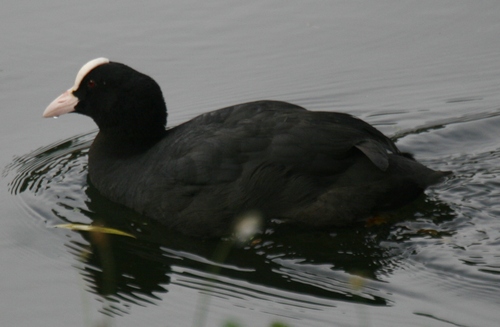Common Coot (Foulque macroule)
Fulica atraSummary 7
The Eurasian Coot (Fulica atra), also known as Coot, is a member of the rail and crake bird family, the Rallidae. The Australian subspecies is known as the Australian Coot.
Biology 8
The coot feeds on pondweeds and invertebrates (4); it dives rather clumsily to obtain food, and returns to the surface rapidly thanks to its cork-like buoyancy (6). Unlike ducks, coots bring their food to the surface before eating it; this results in frequent cases of food stealing (4). They are opportunistic birds, and may feed in grasslands at certain times of the year (6). During winter, large flocks may gather on large lakes and reservoirs (10), these gatherings are relatively peaceful compared to the fierce territorial aggression seen during the breeding season (2). The nest, a mound of dead reeds, is usually built amongst emergent vegetation (6). From mid-March, between 6 and 9 speckled eggs are laid (occasionally up to 15 eggs, though these large clutches may be laid by more than one female (10)). The eggs are incubated by both parents for up to 24 days (6). The chicks leave the nest a few days after hatching, and reach independence at around 8 weeks of age (6). Two broods are produced a year, but occasionally a third brood may occur (6).
Statut 9
Status : Ve
Date d'arrivée record:
Date de départ record:
Il est à noter que la liste des mentions ci-dessous peut inclure certaines mentions non-confirmées ou considérées comme invalides après leur publication. Cette liste est fournie à titre d'information uniquement, et elle est principalement mise à jour grâce aux mentions publiées dans la chronique saisonnière de la revue QuébecOiseaux. Certaines mentions récentes, identifiées avec la référence "web", réfèrent souvent à des mentions publiées sur la page des oiseaux rares du Québec.
Cherchez les mentions de Foulque macroule sur la page des oiseaux rares du Québec.
No Localité Dates Référence
Kegaska 14/12/1995 QO 8(1):25 (photo)
photo publiée
Sources and Credits
- (c) msr, some rights reserved (CC BY-NC), uploaded by msr
- (c) Arthur Chapman, some rights reserved (CC BY-NC-SA), http://farm4.static.flickr.com/3209/3009677146_2f33b16214_o.jpg
- (c) Arthur Chapman, some rights reserved (CC BY-NC-SA), http://farm4.static.flickr.com/3230/3009668174_057fb44076_o.jpg
- (c) Edward Baker, some rights reserved (CC BY-NC-SA), http://farm3.static.flickr.com/2428/3659277715_d86816348b.jpg
- (c) 4028mdk09, some rights reserved (CC BY-SA), https://upload.wikimedia.org/wikipedia/commons/5/55/Bl%C3%A4sshuhn.JPG
- (c) David Cook Wildlife Photography, some rights reserved (CC BY-NC), http://www.flickr.com/photos/16520061@N08/2336934408
- Adapted by Roger Simard from a work by (c) Wikipedia, some rights reserved (CC BY-SA), http://en.wikipedia.org/wiki/Fulica_atra
- Adapted by Roger Simard from a work by (c) Wildscreen, some rights reserved (CC BY-NC-SA), http://eol.org/data_objects/6682134
- (c) Roger Simard, some rights reserved (CC BY-SA)











